Multi-Dimensional Recurrent Neural Networks
Multi-Dimensional Recurrent Neural Networks
The basic idea of MDRNNs is to replace the single recurrent connection found in standard RNNs with as many recurrent connections as there are dimensions in the data. During the forward pass, at each point in the data sequence, the hidden layer of the network receives both an external input and its own activations from one step back along all dimensions.

Clearly, the data must be processed in such a way that when the network reaches a poin in an n-dimensional sequence, it has already passed through all the points from which it will rechive its previous activations.
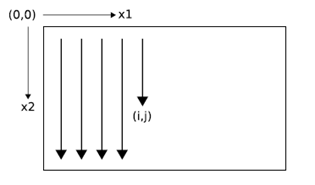
2D sequence ordering. The MDRNN forword pass starts at the origin and follows the direction of the arrows. The point(I,j) is never reached before both (i-1,j) and (i,j-1)
The forward pass of an MDRNN can then be carried out by feeding forward the input and the n previous hidden layer activations at each point in the ordered input sequence, and storing the resulting hidden layer activations at each point in the ordered input sequence, and storing the resulting hidden layer activations. Care must be taken at the sequence boundaries not to feed forward activations from points outside the sequence.
Note that each 'point' in the input sequence will in general be a multivalued vector. For example, in a two dimensional color image, the inputs could be single pixels represented by RGB triples, or blocks of pixels, or the outputs of a preprocessing method such as a discrete cosine transform.
The error gradient of an MDRNN(that is, the derivative of some objective function with respect to the network weights) can be calculated with an n-dimensional extension of the backpropagation through time(BPTT) algorithm. As with one dimensional BPTT, the sequence is processed in the reverse order of the forward pass. At each timestep, the hidden layer receives both the output error derivatives and its own n 'future' derivatives. Figure 2 illustrates the BPTT backword pass for two dimensions. Again, care must be taken at the sequence boundaries.
At a point in an n-dimensional sequence, define and respectively as the activations of the input unit and the hidden unit. Define as the weight of the connection going from unit j to unit k. Then for an n-dimensional MDRNN whose hidden layer consists of summation units with the tanh activation function, the forward pass for a sequence with dimensions can be sumarised as follows:

Defining and respectively as the derivatives of the objective function with respect to the activations of the output unit and the hidden unit at point x, the backward pass is:
Since the forward and backward pass require one pass each through the data sequence, the overall complexity of MDRNN training is linear in the number of data points and the unmber of network weights.
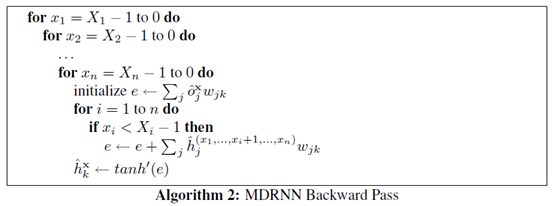
Multi-directional MDRNNs
For one dimensional RNNs, the problem of multi-directional context was solved in 1997 by the introduction of bidirectional recurrent neural networks (BRNNs). BRNNs contain two separate hidden layers that process the input sequence in the forward and reverse directions. The two hidden layers are connected to a single output layer, thereby providing the network with access to both past and future context.
BRNNs can be extended to n-dimensional data by using separate hidden layers, each of which processes the sequence using the ordering defined above, but with a different choice of axes.
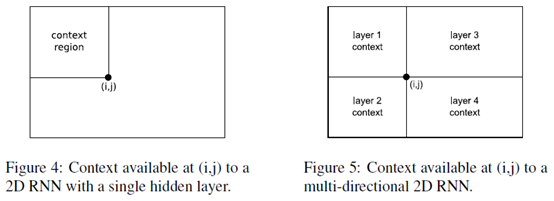
More specifically, the axes are chosen so that their origins lie on the the vertices of the sequence. The 2 dimensional case is illustrated in Figure 6.

As before, the hidden layers are connected to a single output layer, which now has access to all surrounding context.
If the size of the hidden layers is held constan, multi-direcitonal MDRNNs scales as O() for n-dimensional data. In practive however, we have found that using small layers gives better results than 1 large layer with the same overall number of weights, presumably because the data processing is shared between the hidden layers. This also holds in one dimension, as previous experiments have demonstrated. In any case the complexity of the algorithm remains linear in the number of data points and the number of parameters, and the number of parameters is independent of the data dimensionality.
For a multi-directional MDRNN, the forward and backward passes through an n-dimensional sequence can be summarized as follows:


MCGSM
We factorize the distribution of images such that the prediction of a pixel(black) may depend on any pixel in the upper-left green region.
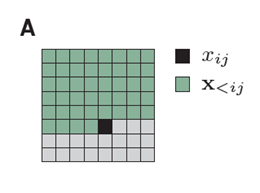
A graphical model representation of an MCGSM with a causal neighborhood limited to a small region.
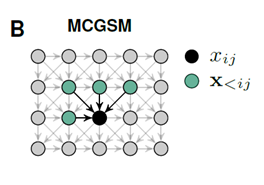
A visualization of our recurrent iamge model with two layers of spatial LSTMs. The pixels of the image are represented twice and some arrows are omitted for clarity. Through feedforward connections, the prediction of a pixel depends directly on its neighborhood(gre-e),but through recurrent connections it hs access to the information in a much larger region(r-ed).
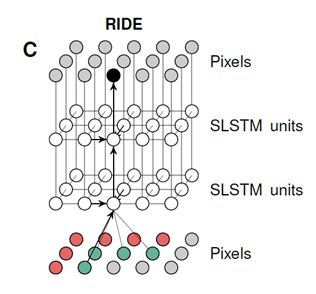
Multi-Dimensional Recurrent Neural Networks的更多相关文章
- The Unreasonable Effectiveness of Recurrent Neural Networks (RNN)
http://karpathy.github.io/2015/05/21/rnn-effectiveness/ There’s something magical about Recurrent Ne ...
- 循环神经网络(RNN, Recurrent Neural Networks)介绍(转载)
循环神经网络(RNN, Recurrent Neural Networks)介绍 这篇文章很多内容是参考:http://www.wildml.com/2015/09/recurrent-neur ...
- Attention and Augmented Recurrent Neural Networks
Attention and Augmented Recurrent Neural Networks CHRIS OLAHGoogle Brain SHAN CARTERGoogle Brain Sep ...
- cs231n spring 2017 lecture10 Recurrent Neural Networks 听课笔记
(没太听明白,下次重新听一遍) 1. Recurrent Neural Networks
- 第十四章——循环神经网络(Recurrent Neural Networks)(第一部分)
由于本章过长,分为两个部分,这是第一部分. 这几年提到RNN,一般指Recurrent Neural Networks,至于翻译成循环神经网络还是递归神经网络都可以.wiki上面把Recurrent ...
- 第十四章——循环神经网络(Recurrent Neural Networks)(第二部分)
本章共两部分,这是第二部分: 第十四章--循环神经网络(Recurrent Neural Networks)(第一部分) 第十四章--循环神经网络(Recurrent Neural Networks) ...
- Pixel Recurrent Neural Networks翻译
Pixel Recurrent Neural Networks 目前主要在用的文档存放: https://www.yuque.com/lart/papers/prnn github存档: https: ...
- 循环神经网络(Recurrent Neural Networks, RNN)介绍
目录 1 什么是RNNs 2 RNNs能干什么 2.1 语言模型与文本生成Language Modeling and Generating Text 2.2 机器翻译Machine Translati ...
- 《转》循环神经网络(RNN, Recurrent Neural Networks)学习笔记:基础理论
转自 http://blog.csdn.net/xingzhedai/article/details/53144126 更多参考:http://blog.csdn.net/mafeiyu80/arti ...
随机推荐
- Ubuntu 配置IP地址方法
接到一客户的服务器,开机已启动发现是Ubuntu系统,当时有点郁闷了,心想没有配置过ubuntu系统,这客户还在旁边了,心里有点紧张了,于是开始上网寻找各种方法配置,最终将IP配置好,给客户上架调试通 ...
- ios 各种锁的使用性能比较
iOS开发中常用的锁有如下几种 来比较一下遇到加锁的情况: 1. @synchronized 关键字加锁 2. NSLock 对象锁 3. NSCondition 4. NSConditionLoc ...
- 【extjs6学习笔记】1.2 初始:MVC MVVM
模型 这表示数据层.该模型可以包含数据验证和逻辑来保持数据.在 ext js 中, 大多数模型都与一个数据存储一起使用. 视图 这表示用户界面. 是用户在屏幕上看到的组件. 在每次互动的用户与应用程序 ...
- Java transient关键字使用
1. transient的作用及其使用方法 我们都知道一个对象只要实现了Serilizable接口,这个对象就可以被序列化,java的这种序列化模式为开发者提供了很多便利,我们可以不必关系具体序列化的 ...
- 洛谷 P2827 蚯蚓
题目描述 本题中,我们将用符号\lfloor c \rfloor⌊c⌋表示对c向下取整,例如:\lfloor 3.0 \rfloor= \lfloor 3.1 \rfloor=\lfloor 3.9 ...
- java面试题(杨晓峰)---第三讲谈谈final、finally、finalize有什么不同?
java语言有很多看起来相似,但用途却完全不相同的语言要素,这些内容往往容易成为面试官考察你知识掌握程度的切入点. 今天我要问你一个基础的java经典题目,谈谈final.finally.finali ...
- cesium-大规模人群运动测试
环境:cesium1.57: 笔记本电脑:集成显卡+独显Navida 1060 测试内容:大规模人群运动(500人,可设置运动的路径),可行性及帧率 测试结果:21-23FPS,较为流畅:集显70%- ...
- Linux OpenGL 实践篇-16 文本绘制
文本绘制 本文主要射击Freetype的入门理解和在OpenGL中实现文字的渲染. freetype freetype的官网,本文大部分内容参考https://www.freetype.org/fre ...
- line-block,white-space,overflow
line-block:设置行间的距离(行高),只能控制块级元素,span这样的行内元素无法控制,并且当块级元素 中包含span的时候设置line-block会使span的自适应高度小于块级元素的高度, ...
- UVA 1600 Patrol Robert 巡逻机器人 (启发搜索BFS)
非常适合A*的一道题. 比普通的迷宫问题加一个信息k表示当前穿过的障碍物的数量. #include<cstdio> #include<cstring> #include< ...
